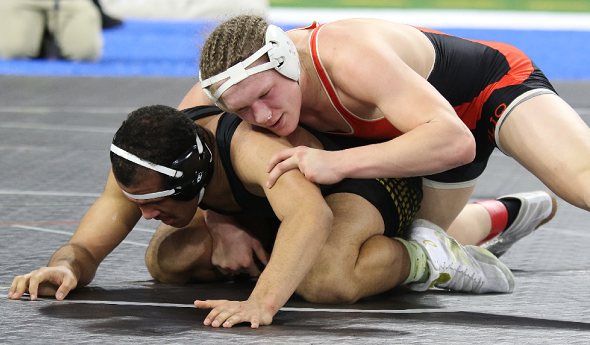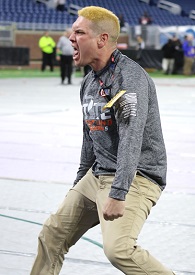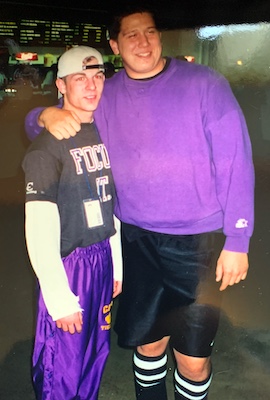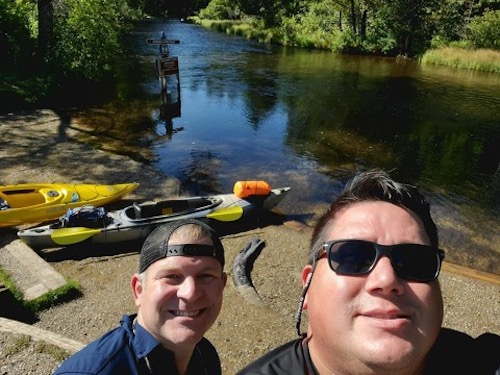
Vance Bounces Back to Finish as Champ
By
Paul Costanzo
Special for MHSAA.com
March 10, 2020
It took a day for Tristan Vance to fully appreciate what he had accomplished.
 The Clio senior won the Division 2 189-pound championship Saturday at the MHSAA Individual Wrestling Finals. Quite often, it takes some time before the gravity of the moment sets in. For Vance, that was partially true. But mostly, he was too sore to celebrate in a big way.
The Clio senior won the Division 2 189-pound championship Saturday at the MHSAA Individual Wrestling Finals. Quite often, it takes some time before the gravity of the moment sets in. For Vance, that was partially true. But mostly, he was too sore to celebrate in a big way.
“That night, I was happy about it and celebrating about it, but I was so sore,” Vance said. “My back started spasming up right after the match. I was just so sore. I wanted to get home, and I wanted to rest. The next day, I was ecstatic.”
The spasms were nothing new to Vance, but rather a painful reminder of what he had to endure to get to this point. He missed more than half of the season because of them and didn’t return to the mat until the postseason.
While Vance himself wasn’t showing the elation and emotion that comes with overcoming what he did, his coach and father, Tony, certainly was understanding of the achievement.
“All I wanted to do is find my wife in the stands and give her a hug and kiss,” Tony Vance said. “It was the best feeling I think I’ve had since my kids were born. I got excited, and I kind of walked to the middle of the mat looking for her. I didn’t know where she was at, then I saw her waving to me. I climbed the wall and gave her a hug. It was such a struggle for him, and so much for us, too.”
The pain started late in the summer for Tristan, but it stemmed from a surgery he had as a 12-year-old. Back then, he was having back pain that effected the way he was walking. After consulting with multiple doctors, a benign tumor was found on his spine.
“I thought I had cancer, and I thought I was going to die – for like 10 minutes,” he said. “Until my mom was like, ‘That’s not what it is.’ After that, I’ve always been kind of chill, not too worried about things.”
The surgery to remove the tumor was successful, but that wasn’t the end of Tristan’s problems. He said he suffered from nerve damage and sciatica. His muscles were still tight, and he had to undergo rehabilitation for his left hamstring.
Eventually, he improved and blossomed into a star athlete at Clio, playing quarterback and linebacker on the football team and earning all-state honors (eighth place) on the wrestling mat as a junior.
That’s what made things even harder when the back pain returned.
“In middle school, none of that mattered to me,” Tristan said. “This year, it really kind of hit a soft spot. I was really depressed about it. I was kind of sure that I wasn’t going to be able to do anything.”
Tristan thought he had another tumor, but that was quickly ruled out. He was told that the smaller muscles around the hole where the tumor used to be were weakened and never fully recovered. The bigger muscles in his back were overcompensating, causing the spasms.
He decided, however, to play quarterback through the football season, even though he ran the ball a lot in Clio’s read-option offense.
“It got so bad where he couldn’t even run sometimes in games,” Tony Vance said. “He would play until he couldn’t play anymore.”
The motivation for Tristan was to play his final season with his friends on the football team. He did admit, though, that if he felt his wrestling season was truly threatened, he may have stopped.
When wrestling season began, the thought was to take things slow. Tristan returned to the mat in January, but his back acted up again in the New Lothrop tournament, and he was once again forced to sit.
“When I had to stop wrestling, it wasn’t because of the pain. It was because my muscles would contract and spasm, and I wasn’t able to do it physically,” he said. “It hurt my feelings. I was like, I don’t know if I’m going to be able to finish the season. I had four other guys on the team that ended up going to the state tournament with me, and I was seeing them do well and I was happy to see that, but I wanted to be part of that so bad.”
 Tristan helped his teammates in the practice room, though he wasn’t sure if he would be able to compete again. As the postseason drew near, he began working out more and preparing for the possibility. The decision was made to put him into the lineup during the Team District and see how he held up.
Tristan helped his teammates in the practice room, though he wasn’t sure if he would be able to compete again. As the postseason drew near, he began working out more and preparing for the possibility. The decision was made to put him into the lineup during the Team District and see how he held up.
“We ended up holding him out as long as we could,” Tony Vance said. “He wrestled (in the Team District) and felt pretty good, so I said, ‘All right, we’ll wrestle you in (Individual) Districts. I was worried, because I didn’t want to have another kid have to sit out, then take him all the way up to Gaylord and enter him into Districts and him not be able to wrestle.”
Tristan entered the District with a 10-2 record. He also entered at 189, despite having wrestled at 171 earlier in the season. He weighed around 180 pounds, and Tony Vance didn’t think adding a large weight cut to the stress already on Tristan’s body was a good idea. The bump didn’t bother Tristan, who was second in the District and first at the Regional.
He entered the Individual Finals as the No. 2 seed. But thanks to having wrestled so few matches, and the presence of undefeated Central Michigan recruit John Shelton of East Grand Rapids on the other half of the bracket, Tristan came in under the radar.
“I had a problem with that last season, where I kind of got in my head a little bit and too full of myself, which really affected me,” he said. “Coming in as an underdog – it wasn’t the most fun way for my last season to be, but it really helped with my mentality coming into the tournament.”
Tristan won handily in his first two matches before running into Fruitport’s Crue Cooper in the semifinals. Cooper was considered by many to be Shelton’s main competition heading into the Finals, but Tristan came away with the 3-1 overtime victory.
“I really wasn’t getting too excited about anything, to be honest,” Tony Vance said of his mindset coming into the tournament. “Me and my wife were just happy that he was able to wrestle again. He won a huge match in the semis. As the match was going, I was like, ‘Man. OK, he’s really looking good.’ After that match was done, I was excited. I thought, whatever happens from here, he’s made a good run. I wasn’t thinking that he was going to win it, I was just thinking that we’d see where it goes (Saturday), and I’ll be able to tell how he’s doing at the end of the first period.”
Tristan was calm as he entered his match against Shelton, even after he was informed right beforehand of Shelton’s credentials.
“I have never wrestled him before, and I have never seen him wrestle before because he’s on the west side of the state,” Tristan said. “My plan was mostly just to get to my tie-ups, get to my offense and do what I do best instead of waiting on what he can do.”
The match was tied at 3 after one period, and Tristan was able to take a 4-3 lead with an escape in the second. In the third period, Shelton chose down, and Tristan built an 8-4 lead thanks to a nearfall and a takedown. An escape and a stalling point put Shelton out of striking distance again, and he threw Tristan in a headlock as the clock was winding down. Tristan was able to get to his stomach, though, preventing the takedown or any back points.
“He has ice in his veins,” Tony Vance said. “He doesn’t have any doubt in himself, but he doesn’t show any emotion. He’s just calm and cool.”
After what could be his final competitive match – Tristan said he’s undecided about his future – he was congratulated by a host of spectators just off the mat, including his teammates and coaches from other schools.
Excited but sore, Tristan calmly walked through it all, not yet fully cognizant of the degree of his remarkable achievement.
“I had a lot of emotions through that time, and I wasn’t really thinking about (going through the injury) too much,” Tristan said. “I was just thinking about what had just happened. Now I’ve realized that I kind of accomplished a lot given my circumstances this year.”
 Paul Costanzo served as a sportswriter at The Port Huron Times Herald from 2006-15, including three years as lead sportswriter, and prior to that as sports editor at the Hillsdale Daily News from 2005-06. He can be reached at [email protected] with story ideas for Genesee, Lapeer, St. Clair, Sanilac, Huron, Tuscola, Saginaw, Bay, Arenac, Midland and Gladwin counties.
Paul Costanzo served as a sportswriter at The Port Huron Times Herald from 2006-15, including three years as lead sportswriter, and prior to that as sports editor at the Hillsdale Daily News from 2005-06. He can be reached at [email protected] with story ideas for Genesee, Lapeer, St. Clair, Sanilac, Huron, Tuscola, Saginaw, Bay, Arenac, Midland and Gladwin counties.
PHOTOS: (Top) Clio’s Tristan Vance works to maintain control in his opening match of the Division 2 Individual Finals against Lansing Waverly’s Demitrius Webb. (Middle) Clio coach – and Tristan’s father – Tony Vance celebrates as Tristan finishes a semifinal win over Fruitport’s Crue Cooper. (Click for more from HighSchoolSportsScene.com.)

Caro Champs Find Common Ground Again as Mental Health Providers
By
Paul Costanzo
Special for MHSAA.com
July 8, 2021
Phil Millerov and Phil Niklowicz wanted to do more than simply defeat opponents when wrestling at Caro High School.
They wanted to dominate – physically and mentally.
 “We had this thing between us where we wanted to be done, and (opponents) didn’t want to come back on the mat with us,” Millerov said.
“We had this thing between us where we wanted to be done, and (opponents) didn’t want to come back on the mat with us,” Millerov said.
Twenty years later, both spend their days building people up. Millerov is a licensed professional counselor, while Niklowicz is a licensed therapist.
“I went out there looking to dominate and make sure it was known that I am the superior wrestler in all facets,” Niklowicz said. “I would try to run up as many points as fast as I can. I would teach the same thing when coaching, specifically with my nephew. You’re saying, ‘Listen, we want to break these people.’ Then the next day, in a therapy session, it’s like, ‘Let’s build up your self-esteem and set some goals to boost ourselves up.’”
The close friends and two faces of Caro’s surging wrestling program in the late 1990s now have very similar careers. Millerov – who finished second, third and first at 275 pounds in the 1998, 1999 and 2000 MHSAA Finals, respectively -- works in private practice at Transitions Counseling Service in Greenville, where he specializes in substance abuse disorders. He also has served as a Class 1 Fellow at the WK Kellogg Foundation.
Niklowicz – a two-time MHSAA Finals champion (1999 and 2000) and four-time placer – is working in private practice in Southfield, seeing mostly children. He also works in adult foster care with patients who have had traumatic brain injuries.
“He and I went and hiked Pictured Rocks at the beginning of May,” Millerov said. “And we joked about how nobody would have guessed that we’d be doing this now.”
That Millerov and Niklowicz are still close does not come as a surprise. Their friendship began when their wrestling careers did, as 6-year-olds in the Caro Growlers program. As they were becoming two of the state’s top wrestlers, they would share rides to tournaments, and their families grew close.
In high school, despite their size difference – Niklowicz wrestled at 135 his senior year – it wasn’t uncommon to see them warming up together.
“We were definitely easy going and liked to mess around a lot,” Niklowicz said. “We used to mess around before meets and throw each other. He would jump and I would throw him. People would look at us like, ‘Why is that little guy throwing that big guy?’”
 While their teams never made it out of the Regional, Millerov and Niklowicz helped set the stage for a program that would become among the best in Division 3 throughout the 2000s, qualifying for five straight Quarterfinals from 2003-07 and winning the Division 3 Finals title in 2003.
While their teams never made it out of the Regional, Millerov and Niklowicz helped set the stage for a program that would become among the best in Division 3 throughout the 2000s, qualifying for five straight Quarterfinals from 2003-07 and winning the Division 3 Finals title in 2003.
Individually, they were among the most well-known and feared wrestlers in the state.
“Niklowicz and I were fortunate to have each other, because we pushed each other,” Millerov said. “We were in constant competition with each other and ourselves. Just to kind of push each other, it was a great thing.”
Niklowicz finished fifth as a freshman and third as a sophomore before winning back-to-back titles to close out his career. In 1999, he defeated Nick Oertel of Goodrich 9-2 in the 125-pound final, and the next year he defeated Oertel’s teammate, Ryan Tripp, 7-5 at 135. Tripp would go on to win an individual title the following year. Niklowicz would finish his career with 214 victories.
“I think probably both (Finals titles) were equal,” Niklowicz said. “I think there was probably a little more stress going into my senior year. My motivation always came from improving, then it was maintaining the state title. You don’t want to go the opposite direction.”
Millerov lost a tight 6-4 decision against Remus Chippewa Hills’ Bob Kozlowski in the MHSAA Finals as a sophomore, and had an epic 12-10 match against future NFL defensive lineman Jason Babin of Paw Paw in the 1999 semifinals before fighting back to take third. The next year, he won his title via first-period pin against Dan Kliphuis, a two-time runner-up from Grand Rapids West Catholic. Millerov finished with 196 career wins and set the state record for pins in a career (160), which was broken the next season by Nick Simmons of Williamston and is now held by Justin Zeerip of Hesperia. The 56 pins Millerov recorded his senior season remains second all-time to Simmons, who had two seasons with 57.
“I never really thought about (the pin record) to be quite honest,” Millerov said. “It was just kind of in the background. It didn’t matter; all I cared about was winning this match, and I wanted to do it in the most effective, efficient way I could.”
They both continued their wrestling careers, but went their separate ways in college, with Millerov heading to Neosho County Community College in Kansas and Niklowicz to Virginia Tech.
Millerov had interest from several Division I schools coming out of high school, including some in the Big Ten, but he admits his grades weren’t good enough at the time. Neosho provided a chance to compete with some of the best in the country while at the junior college level, however, as the team took second at the National Junior College Athletic Association championships in 2002.
He transferred to Central Michigan after his sophomore year, joining his girlfriend – now his wife – who was already attending, and walking onto the wrestling team. While his relationship lasted, wrestling did not.
“I was distracted,” Millerov said. “My grandmother passed away in 2002 in that summer. I was trying to get that motivation back, and I just lost it. There has to be that edge with wrestling. When things didn’t work out, I struggled. Wrestling was my identity.”
Millerov was working to follow in his father’s footsteps and become a police officer. But the elder Phil Millerov, who died in 2012, talked his son out of it.
“Looking back on it, for me, it was obviously the right decision,” Millerov said.
The idea to go into counseling came after Millerov was married in 2006, as his wife had gotten into the program. He went back to school to earn his bachelor’s degree from CMU in 2007, and would go on to get his master’s from CMU, as well.
“I had taken a bunch of psychology courses just because I liked the field,” Millerov said. “I liked to be challenged. I liked puzzles, and with psychology, it’s like a new puzzle every hour. It just clicked. I flew through and graduated with like a 3.8. I was like, ‘Wow, I kind of feel smart.’ It was good to find something I was passionate about again.”
Millerov said he’s constantly learning and honing his craft, much like he did as a wrestler. A major difference now, however, is that he’s found more balance in his life.
“I think about working with athletes in addiction, I find a lot of similarities,” he said. “Wrestling was my life, it’s how I identified myself. I hear that same kind of talk around people struggling with addiction. One you’re considered successful for, the other you’re not. Most of my growth has been around finding balance. I find that my happiness and my clients’ as well, is when we found that balance instead of being good at just one thing. I want you to have passion, I want you to do things you love, but I also want you to be effective as a husband, a father, whatever other responsibilities you have.”
 Niklowicz’s journey to becoming a therapist was more telegraphed, as both of his parents work in mental health, and he said it was always something he wanted to do, as well.
Niklowicz’s journey to becoming a therapist was more telegraphed, as both of his parents work in mental health, and he said it was always something he wanted to do, as well.
He attended Virginia Tech on a wrestling scholarship, but transferred to Eastern Michigan after one year. The Hokies had recruited him to wrestle at 133 pounds, but when the team’s 125-pounder was injured, Niklowicz was asked to cut down further. Like Millerov, he struggled when his wrestling career ended.
“I just had a really bad taste in my mouth after leaving Virginia Tech and trying to cut all this weight,” he said. “Some of it was I had lost the desire to work out, to wrestle. Fifteen years, roughly, of my life was dedicated to wrestling, and once you stop, what do I do with my winters? What do I do with seven months of the year? It was definitely a part of my identity; that’s why I got into coaching. I did MMA fighting for a little bit to have something competitive.”
Like Millerov, Niklowicz said finding balance was important.
“In the mental health field, specifically, there’s a lot of burnout for people,” he said. “Every day, you’re listening to people talking about their problems, but at the same time, they’re coming for a reason and they’re there for help, so you have to provide that help and have to motivate yourself to come to the office every day and give it your best. I try to instill the motivation that I used to other people.”
When Niklowicz looks at his time as an athlete compared to his work as a therapist, he said that work ethic is the main characteristic that has carried over.
“I think my practice mentality was the same as it was on the mat,” he said. “Even in the wrestling room, these are people I’m friends with, people I grew up with, and I still didn’t want anyone to score on me. Then you just look at your work ethic outside of wrestling, whether you’re studying for exams or motivating yourself to get up and go to class.”
While they are no longer living in the same town or living similar lives – Millerov is married with three kids, while Niklowicz is single – the connection between Caro’s dominant duo remains strong, both professionally and personally.
“I don’t think we ever thought we would be going down such a similar path, and I doubt that either one of us grew up thinking we would do the exact same thing,” Niklowicz said. “We met when we were 6 years old, and we’ve been best friends forever. I think it’s hilarious that we’ve taken such similar paths but with some glaring differences. It’s definitely interesting that we’re still really good friends after 30-some years, especially since we’ve moved on and gone our separate ways.”
2020-21 Made in Michigan
June 28: Michigan's Minor Leaguers Making Up for Lost Season - Read
PHOTOS: (Top) Caro’s Phil Millerov lifts teammate Phil Niklowicz as both celebrate Division 3 championships during the 2000 Individual Finals at Joe Louis Arena. (Middle) Niklowicz, left, and Millerov were high school warm-up partners despite wrestling at significantly different weights. (Below) Niklowicz and Millerov take a selfie during a hiking trip to Pictured Rocks National Lakeshore in May. (Photos courtesy of Niklowicz and Millerov.)

